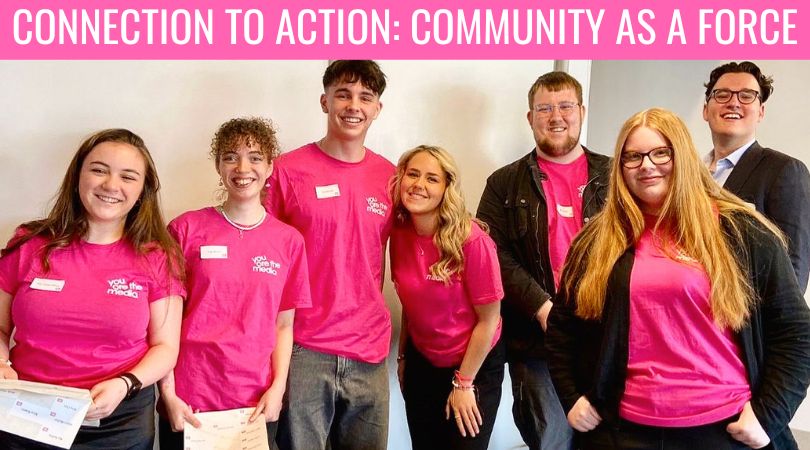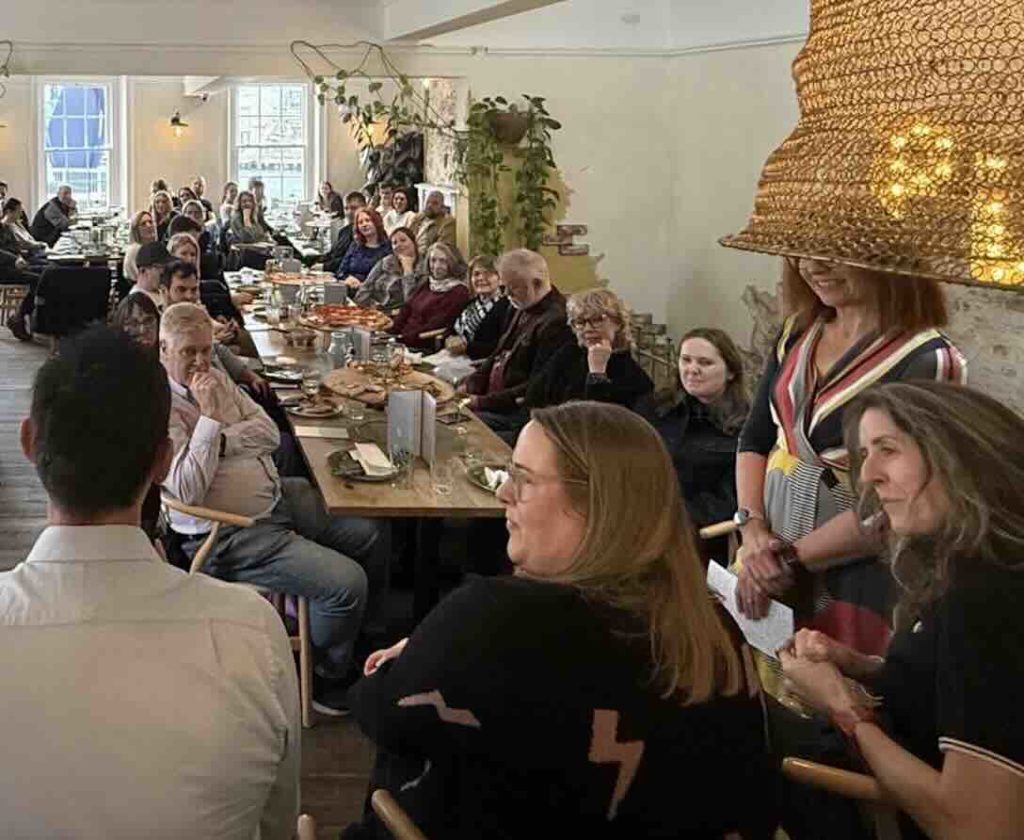Let’s learn and create together!
Book your placeParticipation Over Presence: Why Community Means Action

A community works when people make things happen together.
If you create a space for people, when they become and feel active participants it lifts everything.
In this article, let me share what it takes to progress efforts where people act and where time and energy is shared and not 100% on one person’s shoulders.
The opposite is when you are invited to be a part of a community and the experience isn’t what you anticipated. You have access to a space, but the interaction and bonds between each other is infrequent and doesn’t have a mean to grow, develop and extend.
Where This Started
From now on I am going to champion the use of community with the intention ‘to do.’
We have a membership space, called YATM Club (on Circle) and what has changed since its launch at the end of last summer is the ability to make things happen as a team. This is about doing more together, rather than all eyes on one person to deliver like a teacher at the front of the class.
People suggest ideas, we run with them.
The ideas become extended and we introduce new strands. We’re continually planting seeds and stepping back to see what grows. Rick Rubin says in The Creative Act, ‘it’s helpful to think of the work as bigger than us. To cultivate a sense of awe and wonder at what’s possible and recognise that this productivity is not generated by one hand alone.’
When a community becomes active and participatory, it moves from being a static network to a dynamic force. This shift is what YATM has seen over the years, particularly from 2023 onward, when our community began to embody this idea of doing together, rather than simply existing side by side.
Community as a Noun vs Verb (Think More Verb)
We usually think of community as a group of people who share a common interest.
This is how YATM functioned from 2016 to 2022. This was where people became visible to each other and they connected around shared values and ideas.
It feels good to say ‘I feel a part of this community’ as it helps give us a sense of place. Whether online or offline, where people feel more connected with each other, it becomes easier to introduce others.
If we really want to understand the full potential of what a community means, we need to see it as a verb. This means something active and does so much more than exist. This is where people act, collaborate, and build something greater than they could alone.
NOUN:
A group of people who share a common interest or identity.
They are gathered, but the interaction remains surface-level. People may come together, but their bonds don’t grow as a result of any shared action. This was YATM from 2016 to 2022—a gathering place, yes, but without the deeper, more meaningful interactions that foster real connection.
VERB:
A group of people who actively make things happen together.
They collaborate, create, and contribute, forming stronger bonds and building momentum through their shared actions. This is what YATM has grown into since 2023, as we’ve moved toward a model where community members do together, not just exist together.
It’s much easier to think of community as a noun—simply gathering a group of people. But if you want a rich, vibrant experience, you have to make community work as a verb. This requires deeper engagement, mutual effort, and a shared sense of purpose. It takes work, but tastes so good when it works.
I’m sharing with you to reflect on the changes in YATM. Active engagement is the key difference when it comes to longevity. In the past, people would attend events or read a newsletter. But there wasn’t always a strong back-and-forth. I now treat the YATM Club space as the advisory/action board. Now, it’s about asking: “Who wants to host an event?” or “Who has an idea they want to put forward?” The focus has shifted from passive participation to active contribution.
The Power Of Active Communities
Listening to an episode of Indie Busines Club with Mel Barfield and Ben McKinney, the discussion around community hit home. Ben picked on the importance of community providing the opportunity to lead. Ben leads our Sense Check sessions each month and the ideas we have in our head that we never get to share.
You can listen to the show below…
Ben explains, “To me community means collaboration and involvement. I don’t want to join a community where I’m member number 2,799 and where I’m spoon fed resources or opinions of the founders. I want to be involved, take the lead, offer help, ask for help and I want to be seen and recognised for these things too.”
This is what I mean around a verb. Leadership isn’t about one voice taking charge, it’s about creating an environment where people can step up, collaborate and share their strengths.
The community verb isn’t about creating a fan club, it’s about developing a culture of shared leadership. People are encouraged to step forward, offer their ideas, and take part in shaping the community.
Ella Orr sums it up simply, “For me, community is always about the ‘doing’ and ‘working together’. That’s how we grow and truly get to know each other as human beings.” Her words capture the essence of what makes a community thrive. It’s not just about being present—it’s about doing things together, working toward common goals, and building stronger connections in the process.
Darren Slade echoed this sentiment, saying, “A community isn’t something you’re just ‘in’; you have to contribute to it.” The act of contribution is where real value lies. When people feel empowered to contribute, they move from being passive recipients of content to active participants in the community’s growth and success.
Engagement as Action
When you start viewing community as a verb, the concept of engagement changes.
It’s no longer about one-way interaction, such as attending an event or passively consuming content. Engagement becomes a continuous, back-and-forth dialogue where every member has a role to play.
For example, YATM Lunch Clubs are no longer about attending a work/networking event. Instead, they’ve become a space where people can take part in meaningful discussions, lead panels, speak and share what they are doing to the group. The power of this approach is that it turns attendees into contributors. They don’t just show up—they shape the event through their involvement.
If creating this sense of community for you and your work is a place where you want to head, collaboration is the heart of community success. When we create spaces where people can share their ideas, learn from one another, and contribute to something larger than themselves, we unlock the full potential of community. It becomes a place of mutual growth, where everyone has a stake in the outcome.
This is about action (verb) not just identity (noun).
How You Can Bring In Action To An Active Community
So how do you take community from a noun to a verb? Here are some key steps I’ve learned through my experiences with YATM:
Emphasise Participation:
Give people a reason to step up. Ask for ideas, invite people to lead discussions, and create opportunities for others to take part. Don’t let the community be a one-person show. You never know the talents and skillsets that other people posses, that you never saw before.
Make It Easy To Join In:
Build systems that allow for easy collaboration. Whether it’s through live events, online forums, or small working groups, create spaces where people can work together and contribute their ideas. You need a means where it is seen by the group, rather than a LinkedIn post seen by people you are not familiar with.
Acknowledge Contribution:
Celebrate the people who step up and contribute. By acknowledging their efforts, you encourage other people to do the same. This recognition builds momentum and keeps people engaged. Plus it feels good when people are seen for their work. Too often people work in silos hoping for the attention from an anonymous audience
Create Shared Goals:
Communities thrive when they have a common purpose. Whether it’s launching a project, building new skills, or simply supporting one another, having shared goals gives the community a sense of direction.
Empower Leadership:
Encourage people to take ownership of different aspects of the community. As Darren Slade noted, being part of a community means contributing, and that means creating space for others to lead.
Promote Interaction:
The communities who will win will be those that prioritise interaction. Encourage people to connect with one another, form smaller groups, and have ongoing discussions. This builds trust and deepens relationships. In YATM Club, we have separate DM Groups related to the sessions we have.
Let’s Round-Up
The goal is to create a place of action, not just a static group.
It’s where people feel empowered to share, contribute, and lead. The result is a stronger, more vibrant community that produces real outcomes, both for its members and for the wider world.
As we’ve seen with YATM, this approach has transformed what was once a simple gathering of like-minded individuals into a thriving, active network of people who do together. The bonds are deeper, the conversations more meaningful, and the results more impactful. That is where I want to progress, I want to be with people who want to do more together.
So ask yourself—are you part of a community that simply exists, or one that acts? If it’s the latter, you’re creating something truly powerful.
The importance of action is within YATM Club, this is our membership space. Maybe you’d like to come and join in and feel a part of what’s happening? Read more here and what other people think.
Build Your Community
A brand new programme from Mark Masters for businesses wanting to make that next growth step.
Find out moreYATM Club
Where non-conformist business owners come to work, learn and make friends. Click here

